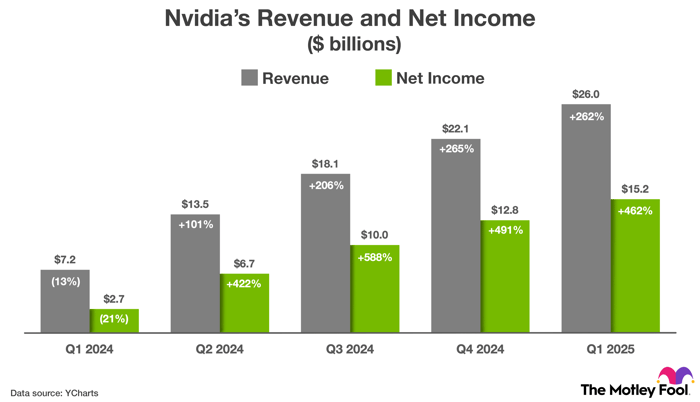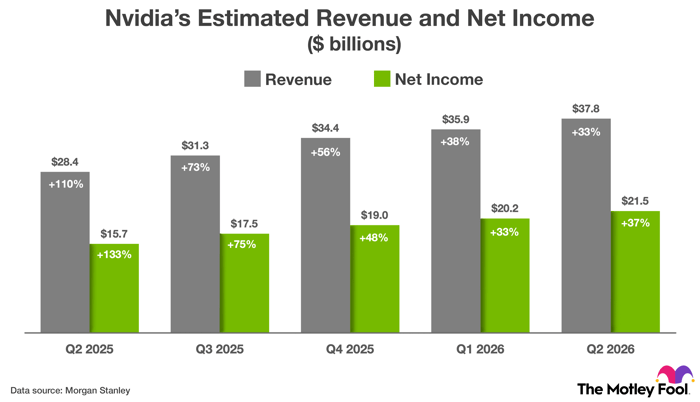Nvidia has generated monstrous returns over the past 18 months, but some analysts see more upside potential for shareholders.
Nvidia (NVDA 4.57%) Stocks have literally driven the stock market higher. Since January 2023, the stock has risen 740% due to the excitement surrounding artificial intelligence. S&P 500 In other words, Nvidia has generated about a fifth of the S&P 500’s gains over the past 18 months.
Nvidia revived its stock price rally by doing a 10-for-1 stock split in June, its second split in three years. Shares have since traded sideways, but Wall Street remains bullish. Nvidia has an average price target of $136 per share, implying an 11% upside from its current price of $122 per share.
The highest price target comes from Hans Mosesmann of Rosenblatt, who estimates Nvidia will climb 64% to $200 per share by June 2025. The lowest price target comes from Gil Luria of DA Davidson, who estimates Nvidia will decline 26% to $90 per share over the same period.
Read on to learn more.
Nvidia has a significant competitive advantage in its software support ecosystem
Nvidia’s graphics processing units (GPUs) are great at accelerating complex data center workloads like artificial intelligence (AI). The company regularly sets performance records in MLPerf benchmarks and objective tests for AI technologies, and has a market share of over 80% in AI chips. But Nvidia is truly formidable because it has reinforced its dominance in AI chips with an ever-expanding ecosystem of supporting software.
In 2006, Nvidia introduced the CUDA programming model, a software layer that allowed its GPUs (originally designed for computer graphics) to function as general-purpose data center processors. “Millions of lines of code have been written over the years for CUDA, making it easier to develop new AI applications using Nvidia’s chips,” according to The Wall Street Journal.
More recently, Nvidia introduced AI Enterprise, a suite of pre-trained models and software tools that streamline the development and deployment of AI applications across a wide range of use cases. For example, the AI Enterprise suite includes frameworks for recommendation systems, logistics route optimization, conversational assistants, cybersecurity threat detection, and autonomous robots.
Hans Mosesmann, an analyst at Rosenblatt, sees a significant competitive advantage here. “The real argument lies in the software that complements all the hardware qualities,” Mosesmann recently told clients. “We expect this software aspect to increase significantly over the next decade in terms of the overall sales mix.”
On the other hand, DA Davidson analyst Gil Luria fears that Nvidia will derive most of its revenue from Amazon, Alphabet, MicrosoftAnd You’re hereAll four companies are developing their own AI chips to replace Nvidia GPUs. Luria believes competition will be problematic, saying: “Beyond the next four to six quarters, we believe a decline in demand for Nvidia compute is inevitable.”
Both analysts make valid points, but Mosesmann’s argument seems to outweigh the concerns raised by Luria. Competitors are indeed building custom AI chips, but history suggests they will need a comparable software ecosystem to truly displace Nvidia. Alphabet, for example, has been using custom AI chips called Tensor Processing Units (TPUs) for nearly a decade. But Nvidia GPUs remain the gold standard.
Indeed, Toshiya Hari at Goldman Sachs Nvidia isn’t worried about the competition. “We believe Nvidia will remain the de facto industry standard for the foreseeable future, given its competitive advantage across hardware and software capabilities,” it wrote in a note to clients. “Nvidia’s annual introduction of new products and platforms gives the company a pace of innovation that allows it to remain at the forefront of the industry.”
Wall Street has high expectations for Nvidia’s revenue and profit growth
Nvidia reported exceptional financial results for the first quarter of fiscal 2025 (ended April 28, 2024). Revenue increased 262% to $26 billion and non-GAAP net income jumped 462% to $15.2 billion. CEO Jensen Huang said the growth was “fueled by strong and accelerated demand for generative AI training and inference solutions.”
What makes Nvidia’s first-quarter performance particularly impressive is that it comes on top of triple-digit growth in the previous three quarters, as shown in the chart below.

Nvidia’s non-GAAP revenue and net income have grown at a triple-digit pace for four consecutive quarters.
Wall Street analysts have high expectations for Nvidia. The chart below shows consensus estimates for non-GAAP revenue and net income for the next five quarters.

Wall Street expects Nvidia to rapidly grow its revenue and non-GAAP net income over the next five quarters.
Nvidia stock trades at a tolerable valuation relative to Wall Street earnings estimates
I mentioned earlier that Nvidia shares have gained 740% since the beginning of January 2023. After this price appreciation, investors might assume that Nvidia is trading at an exorbitant valuation. But the stock is currently trading at 72 times earnings, a discount to the three-year average of 87 times earnings and the five-year average of 80 times earnings.
Wall Street also expects Nvidia to grow its earnings per share by 33% per year over the next three to five years. So the current valuation looks tolerable. Investors shouldn’t fool themselves into thinking the stock is cheap. But Nvidia remains one of the best ways for patient investors to expose their portfolios to AI, a market that’s expected to grow by 36% per year through 2030.
Suzanne Frey, an executive at Alphabet, is a member of The Motley Fool’s board of directors. John Mackey, former CEO of Whole Foods Market, an Amazon subsidiary, is a member of The Motley Fool’s board of directors. Trevor Jennewine holds positions in Amazon, Nvidia, and Tesla. The Motley Fool holds positions in and recommends Alphabet, Amazon, Goldman Sachs Group, Microsoft, Nvidia, and Tesla. The Motley Fool recommends the following options: long January 2026 $395 calls on Microsoft and short January 2026 $405 calls on Microsoft. The Motley Fool has a disclosure policy.